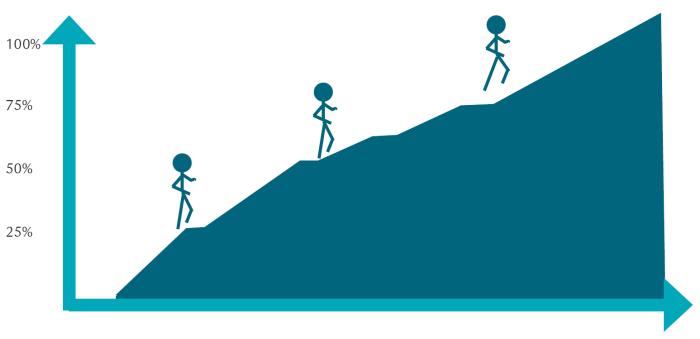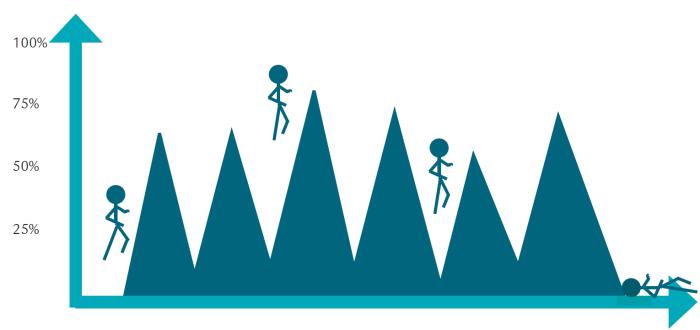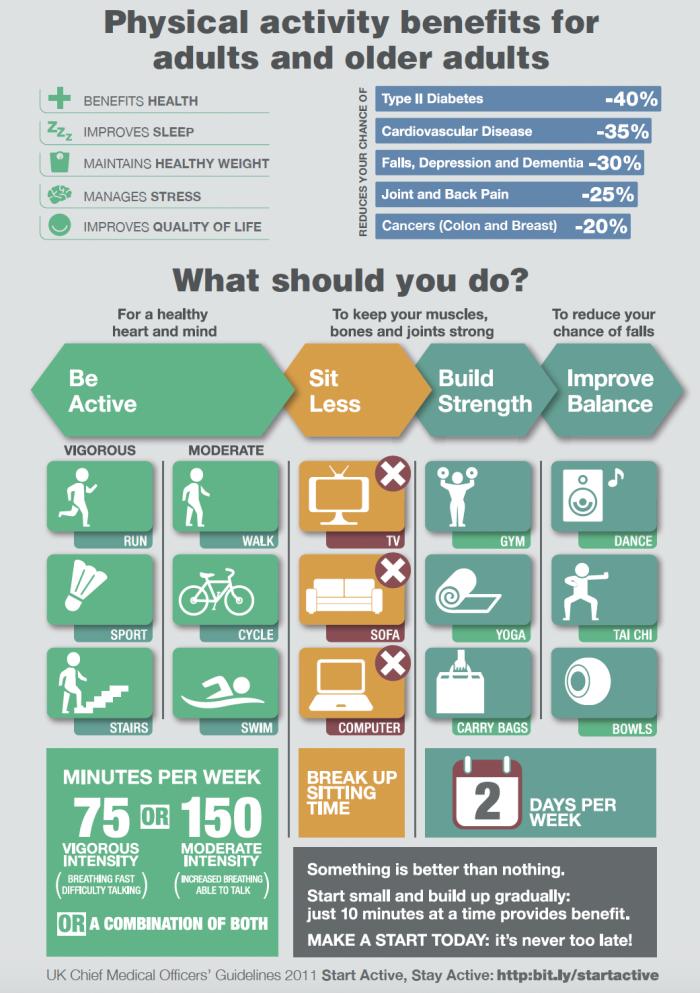Plantar Fasciitis
Dealing with Plantar Fasciitis
Consistent and progressive activity over time
The plantar fascia (the tissue on the sole of the foot) does not like long periods of inactivity (we call this underloading) but it also doesn’t like suddenly doing more than it’s used to (overloading). There is no upper threshold on how much pain you can work into but consistent activity is important. Find a level which is challenging yet repeatable (i.e. you can do it day in; day out). You can build this up over time, as your foot gets used to it.
You can think of building these activities back up as a ladder. Your start point will depend on how tolerable your symptoms are, as well as your general fitness, while your end point will depend on your goals. An example may look like this, over the course of several weeks:
- Start with a medium paced walk on the flat, over a short distance…
- gradually increase the distance…
- add in some gentle slopes….
- increase the pace…
- add in some bigger hills… and so on.
Notice how it’s gradual, steady and methodical. You progress to the next step as it gets easier. Having a plan like this, will help you get back to your normal activities.
You want your progress to look like this:

Not like this:

Keeping active
If the intensity of pain is such that you cannot tolerate your normal activities, such as running or walking, then consider other ways of maintaining your fitness in the meantime.
There is no set approach that has been shown to be the best so feel free to try different types of exercise and activity. Be guided by what you enjoy and what you feel able to start. Examples include cycling, swimming, lifting weights or going to an aqua-aerobics class. Gym equipment like a rowing machine or static bike can provide cardiovascular fitness benefits without aggravating the foot.

If you are local to Sheffield and you would like support to increase your physical activity,, then you can
- Self-refer to Move Well for personalised support and access to a wide range of physical activity opportunities, tailored to your specific needs and preferences.
- Find sport, leisure and activity groups in your local area
- Visit our page on physical activity under the wider health section of the website for further guidance and support to increase your activity.
Simple activity modification
Your foot may be more sensitive to standing or being on your feet for prolonged periods. Where possible, try to break up long periods of standing. Over time, as your foot is more able to tolerate this activity, you can gradually build this back up.
Wearing minimalist shoes or walking barefoot can be painful too, so consider your choice of footwear, to prevent your foot from being unnecessarily aggravated. Read on for more advice about footwear.
Weight management & nutrition
If you are living with overweight or obesity, modifying your diet to lose weight can reduce symptoms. Being in a sensible calorie deficit and following a balanced, nutritious diet is best for losing weight in a sustainable manner. Visit the healthy weight page under the wider health section of the website for guidance and support with losing weight.
Footwear
Suitable footwear can assist your recovery. We recommend shoes which:
- are supportive and comfortable
- do not compress your feet too much
- have a small heel (i.e. they are not completely flat)
- have cushioned soles, especially in the heel area
For more information, please visit our footwear advice page.
Taping
Research has shown that taping can be a helpful way to reduce foot pain due to plantar fasciitis, in the short term. It can take the pressure off the tissues in the foot, allowing you to stay active. It can also be very useful to do whilst building up your normal activities again.
This video demonstrates the taping method, which you can do at home, for plantar fasciitis.
You need a good zinc oxide tape which can be found here but available on many websites Zinc Oxide Tapes | Taping & Strapping | FirstAid4Sport.
How to: Low-dye taping
Foot orthoses
Orthotics can be often helpful in offloading the plantar fascia. Likewise Gel heel cups are helpful for providing cushioning under the heel. Some good examples are;
Orthotics can be often helpful in offloading the plantar fascia. Likewise Gel heel cups are helpful for providing cushioning under the heel. Some good examples are;
- Bailey Versatile Insoles – Bailey Instruments
- Silicone Gel Heel Cups – Healthy Step
- Buy HeelFixKit for Pain Relief – Healthy Step
Heat or Ice packs
Heat packs
You may find that applying heat to the sore area helps relieve your pain and any associated muscular soreness. Use a microwaveable wheat bag or a hot water bottle wrapped in a towel. Keep it on for 15 – 20 minutes, checking your skin regularly to minimise the risk of suffering burn. Repeat 2-3 times per day. Do not place heat on a swollen body part.
Ice packs
This can help to temporarily numb pain. Apply an ice pack (or a bag of frozen vegetables wrapped in a tea towel) to the area for up to 10 minutes, 2-3 times per day.
Massage
Massage of the heel and arch area may help to temporarily ease the symptoms. Initially it can be tender to do so but over time it should become more comfortable. You can use your fingers, someone else can do it, or you can use something such as a rolling pin or a tennis ball to roll over the foot. Do this for about 3-5 minutes at a time, once or twice a day.
This video demonstrates this self-massage technique:
Plantar Fascia Self Massage
Pain medication
Pain medication may help to manage the pain, allowing you to keep mobile. Speak to a pharmacist or your GP for further advice.
Further Treatment
Podiatry
Not everyone needs to be seen by a podiatrist. Some people get better on their own, usually when resting is brief, and normal use and activities are resumed. However, some people may need a more tailored programme. The evidence has shown that the best first-line management of plantar fasciitis is rehabilitation. This should include active strategies such as targeted and individualised exercises. The good news is that the prognosis for this condition is very good, but it’s likely to be slow. It can take several weeks or months, so be patient and work with your podiatrist to get the most from your programme.
Steroid injections
Steroid injections have been used to treat this condition however research has shown them to be ineffective in the long term and they risk reducing the health and integrity of the plantar fascia.